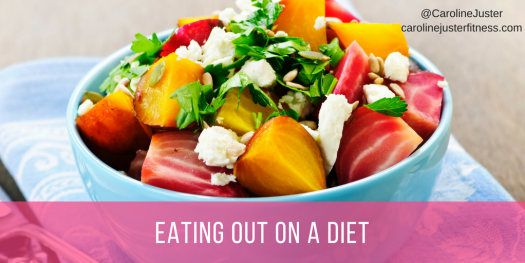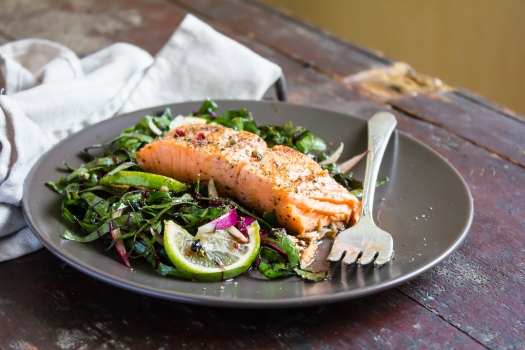
For many people, eating out at restaurants is one of life’s greatest joys. Even though I love to cook, restaurants offer a break from planning, prepping, and cleaning and allow me to try dishes I would never make for myself at home.
However, as I’ve recently embarked on a fat loss diet, I’ve had to adjust how I dine out. Dealing with restaurants is one of the number-one battles for my fat loss clients. Many of them struggle to make healthy choices at lunchtime meetings with clients or coworkers and at weekend social outings with friends and family. Others simply don’t like to cook and find that restaurants are more convenient after a long day or on business trips. With so much variety and temptation, it can be a challenge to know what to order and how to keep portions in check.
Below, I have provided some of my favorite strategies for making healthy choices at restaurants. Although this article is specifically geared towards those trying to lose fat, it can be valuable for anyone trying to maintain their weight or simply eat healthier.
Be Honest
Before discussing how to manage your restaurant experience, it’s important to be honest with yourself about how often and why you are eating out. For best results when dieting, you need to be cooking most of your meals at home. Even with the best intentions, you can’t totally control what a restaurant puts in your meal or how your food is prepared. You may be surprised at all the ways sugar, fats, and other flavor enhancers can be hidden in your order.
Limit yourself to eating out only once or twice a week. If you know you need to eat out more than twice for work, try to be especially disciplined with your ordering and make sure you are not splurging with too many additional social dinners and brunches over the weekend.
Plan Ahead
If you have control over where you eat, shop around for healthier options. Look at menus online and make sure you have several meal possibilities before you chose a restaurant. Certain kinds of restaurants tend to have healthier food than others. Fast casual (think Chipotle, Roti, Sweet Greens, etc.), grab-and-go (Freshii, Snap Kitchen, Pret a Manger), Mediterranean, seafood, steakhouses, and even traditional taquerias can all provide decent selections of grilled proteins, vegetables, and healthier carbs.
Many chain restaurants provide detailed nutrition information for their dishes, which is helpful if you count calories or macros. If you don’t get to choose where you eat, you can still look at the menu beforehand to figure out what you will order. Wherever possible, pick out your meal ahead of time so you won’t be tempted by things you see other people eating at the restaurant. Planning ahead sets you up for success.

What to Order (and not to order)
Salads can be your best friend when eating out at restaurants. A good restaurant salad provides tons of vegetables, protein, and healthy fats. Restaurant salads are often way tastier than salads you make at home because they add variety that you might not have the time or resources to prepare yourself. I recommend asking for the dressing on the side, as restaurants often add much more than is necessary. Some restaurants will also bring out some olive oil and vinegar if you ask, allowing you to make your own healthier dressing. In general, choose salads that are heavy on lean proteins and fresh fruits and vegetables and are lighter on more calorie-dense foods like dried fruits and nuts, tortilla strips, bacon, and cheese.
Another great alternative is to order some kind of lean grilled or broiled protein. Lean steak, chicken, fish, eggs, and pork are all great options. Avoid entrees that are breaded, fried, or smothered in tons of sauce. Choose a side salad, vegetables, or a healthier carb such as rice or potatoes (keeping an eye on portion sizes) as your side dish for a well-balanced meal.
Avoid eating free appetizers such as bread or chips and salsa. If you know a restaurant brings these things out, ask the waiter to skip your table. Munching on these items can add hundreds of empty calories to an otherwise healthy meal.
Additionally, go easy when adding condiments, sauces, and dressings to your meal. These are often loaded with extra calories, sugar, and fats and can dramatically bump up the calorie count of your meal.
Portion Control
Even if you make a smart choice when ordering, restaurants often serve way more food than you need at one sitting. As soon as you get your food, ask for a to-go box and pack away half of your meal for later. This is especially important when ordering carbs such as rice or potatoes because restaurants often serve two to three servings or more of these items.
As a rule of thumb, men can consume two palm-sized servings of protein, two cupped-hand-sized servings of vegetables, two thumb-sized servings of fats, and two fist-sized servings of carbs with each meal. Women should typically limit consumption to one serving of each. Eating slowly and savoring every bite can help prevent overeating. Remember that you don’t always have to eat everything on your plate!
Indulging Intelligently
Sometimes you just want to cut loose and indulge, even when you are trying to lose fat. In this situation, I recommend that you observe the following rule to avoid going overboard: pick either alcohol (1-2 drinks), a starchy or fatty side or appetizer (fries, mac and cheese, anything breaded or fried, etc.), or a dessert to share. For example, have a steak with grilled vegetables and share a brownie sundae for dessert. Or order a burger and fries but skip the drinks and sweets.
Avoid falling into the all-or-nothing trap by understanding that a small indulgence won’t wreck your progress. However, if you choose to dive head first into cheat meals week after week, you risk eliminating your hard-earned calorie deficit and thus frustrating your long-term fat loss progress.

Enjoying Restaurants While Dieting Isn’t impossible
It is absolutely possible to enjoy eating out and still lose fat. However, you do need to be honest with yourself, plan ahead, and exert a bit of self-control. For best results, limit dining out to once or twice a week. Choose restaurants where you can order healthy, delicious meals such as salads, lean proteins, and vegetables. Box up half of your meal, eyeball portion sizes using your hand, and eat slowly to avoid consuming too much food at once. When you do indulge, make sure to keep things in check instead of diving off the deep end and ordering all the alcoholic, fried, and sweet things on the menu at once.
If you want more information like this, sign up for my email list. I send out weekly tools, tips, and strategies to help busy professionals get in great shape without losing their minds.

